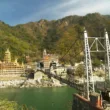In the heart of the city of Rishikesh, known for its spiritual atmosphere and breathtaking scenery, lies the iconic suspension bridge known as Ram Jhula. This architectural marvel spans the majestic Ganga River, connecting Swarg Ashram and the bustling Gita Bhavan. Ram Jhula is one of the most revered attractions in Rishikesh and fascinates visitors for its rich history, cultural significance, and panoramic views of the surrounding Himalayas.
Historical Overview: Origin and Significance
Ram Jhula holds a special place in Hindu mythology as it is believed to be the place where Lord Ram’s brother Lakshman crossed the Ganges using a jute rope. Over time, this humble junction evolved into the magnificent suspension bridge we see today, a symbol of spiritual transcendence and faith.
Architectural Marvel: Design and Construction
Built-in the 1980s, Ram Jhula is a testament to human engineering and engineering skills. About 450 feet long and suspended more than 60 feet above the river, the bridge exudes elegance and power. Its intricate design, characterized by strong iron cables and vibrant orange hues, blends perfectly with the natural beauty of its surroundings, creating a harmonious blend of man-made and natural elements.
Similar Article – Thrilling White Water Rafting in Rishikesh
Spiritual Paradise: Ram Jhula and its surroundings
Apart from its architectural grandeur, Ram Jhula is a gateway to spiritual enlightenment and peace. As visitors cross the bridge, they are greeted with soothing chanting of mantras and a gentle breeze carrying the scent of incense. There are many ashrams, temples, and yoga centers along the bridge that offer seekers a haven of meditation, yoga, and self-reflection.
Sights: What to See and Do
1. Parmarth Niketan Ashram
Located on the banks of the Ganges, Parmarth Niketan Ashram is a spiritual oasis with daily yoga classes, meditation sessions, and divine Ganga Aarti ceremonies. Visitors can immerse themselves in the serene atmosphere and engage in soul-nourishing activities led by experienced yogis and spiritual gurus.
2. Swarg Ashram
Known for its serene atmosphere and natural beauty, Swarg Ashram is a haven for spiritual seekers and nature lovers alike. Here you can explore charming walking trails, visit ancient temples, or simply enjoy the peace of the surroundings while doing yoga or meditation.
3. Triveni Ghat
The sacred banking field is located at the confluence of three holy rivers – Ganga, Yamuna, and Sarasvati. Triveni Ghat is a reputed pilgrimage site where devotees gather to perform rituals, offer prayers, and seek blessings. Witnessing a lively evening aarti ceremony, Triveni Ghat is a mesmerizing experience that leaves a lasting impression on visitors.
Similar Article – Places To Visit in Rishikesh
Conclusion: Embracing the essence of Ram Jhula
In essence, Ram Jhula transcends its role as a mere bridge and emerges as a symbol. . . about spiritual awakening and cultural heritage. As travelers begin their journey through this iconic landmark, they are not only greeted by breathtaking views but are also invited deeper into the spiritual tapestry of Rishikesh. Whether you seek solace in nature, explore ancient traditions, or embark on a journey of self-discovery, Ram Jhula welcomes you with open arms, promising an unforgettable experience of serenity and enlightenment.









